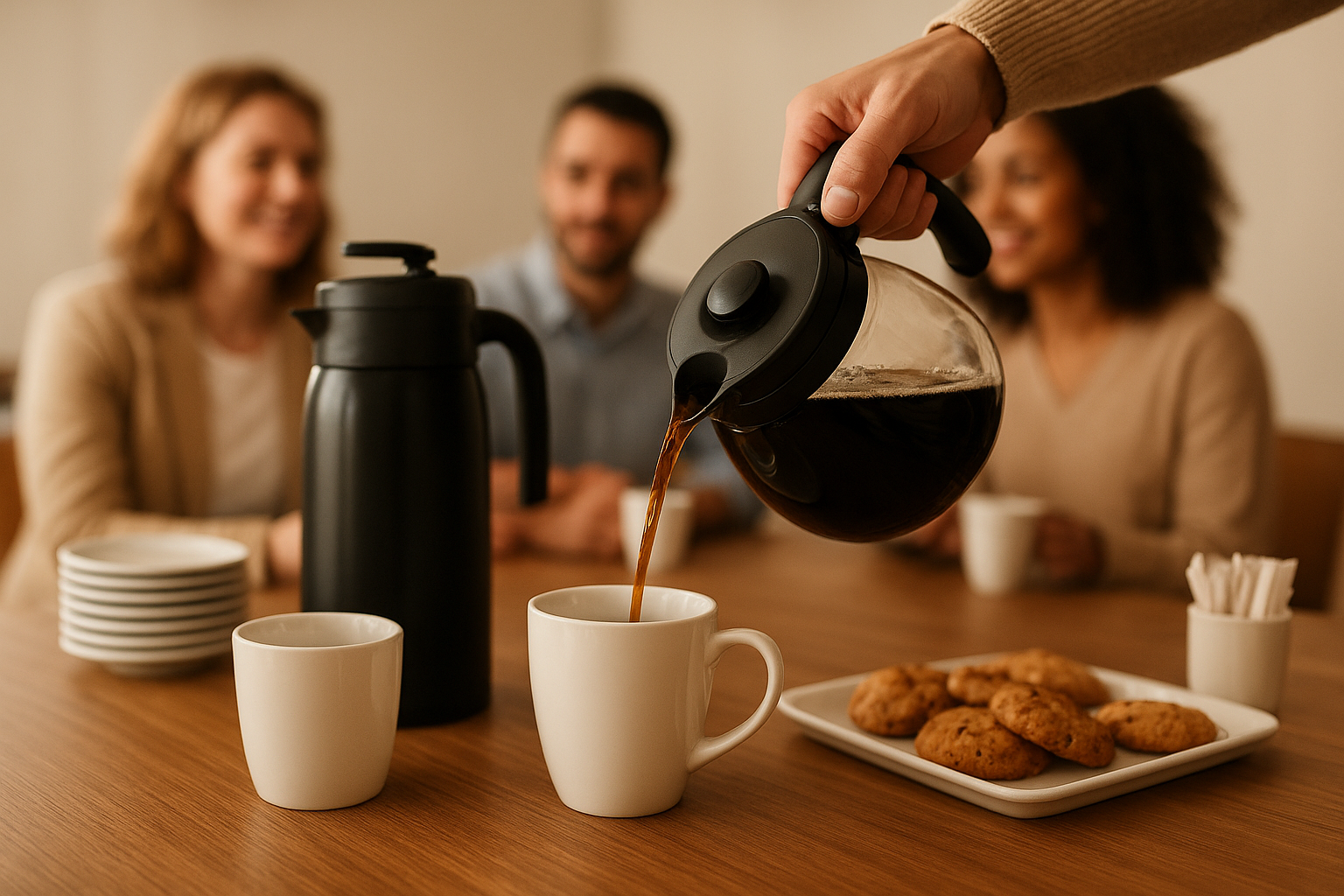Coffee has long been a symbol of connection, hospitality, and energy. Whether it is a casual family gathering, a professional meeting, or a large event, the way coffee is served can leave a lasting impression on your guests.
More than just pouring a hot beverage, serving coffee in these contexts involves attention to detail, consideration of preferences, and creating an environment where people feel welcome. By mastering the art of serving coffee, you enhance both the drink itself and the experience surrounding it.
Why Coffee Matters at Social and Professional Events
Coffee is not just about caffeine—it is about culture and comfort. In social gatherings, coffee helps people relax, feel included, and engage in conversation.
In professional settings, it signals thoughtfulness, encourages alertness, and creates a break from the intensity of discussions.
Offering good coffee shows respect for your guests’ time and preferences, and it elevates the overall atmosphere of the occasion.
Choosing the Right Coffee for the Occasion
The type of coffee you serve should match the context. For informal family gatherings or small get-togethers, you may offer a range of simple options, such as brewed coffee, espresso, or even flavored varieties.
For business meetings, it is best to stick to high-quality, classic options such as filtered coffee, espresso, or Americano—drinks that appeal to a wide audience without being overly complicated.
In larger gatherings, having multiple varieties, including decaf, ensures that every guest finds something suitable.
Quality Over Quantity
When serving coffee, quality always matters more than quantity. A small but well-prepared cup of coffee can impress far more than an endless pot of poorly brewed coffee.
Investing in freshly ground beans, proper equipment, and clean brewing water can significantly improve the taste. Guests will notice and appreciate when care is taken in preparing their coffee.
Offering Variety and Catering to Preferences
Not everyone enjoys coffee the same way. Some people prefer strong espresso, while others like a lighter, smoother brew. To accommodate everyone, consider offering:
- Regular brewed coffee or pour-over for classic drinkers
- Espresso-based drinks for those who enjoy intensity
- Decaffeinated options for people avoiding caffeine
- Milk alternatives such as almond, soy, or oat milk for those with dietary restrictions
- Sweeteners beyond sugar, including honey, stevia, or syrups
This flexibility shows thoughtfulness and ensures no one feels left out.
Presentation Matters
The way coffee is served influences how it is perceived. Instead of using disposable cups, opt for clean, well-designed mugs or cups when possible, especially in smaller gatherings or professional meetings.
For large events, high-quality paper cups with lids may be more practical but should still look presentable.
Adding small details, like serving on trays, offering stirrers, or presenting coffee with a small cookie or chocolate, elevates the experience.
Timing the Coffee Service
Timing is critical. In social gatherings, coffee is often best served after a meal, as it signals comfort and encourages conversation to continue.
In professional meetings, offering coffee at the beginning helps participants feel energized and focused, while serving it during breaks provides refreshment and encourages informal networking.
For all-day events, having coffee available throughout ensures that people stay engaged and satisfied.
Creating a Coffee Station
For larger meetings or gatherings, setting up a self-serve coffee station can be highly effective. This allows guests to customize their drinks and avoid waiting. A good coffee station should include:
- Freshly brewed coffee kept warm in thermal carafes
- Espresso machine or pod machine if available
- A selection of milks, cream, and non-dairy alternatives
- Sugar, sweeteners, and flavor syrups
- Cups, lids, stirrers, and napkins
The key is organization—everything should be easy to access and neatly arranged so guests feel comfortable serving themselves.
Pairing Coffee with Food
Serving the right food alongside coffee enhances the experience. For casual gatherings, cookies, pastries, or cakes complement coffee beautifully. For professional settings, small snacks like biscotti, fruit, or simple baked goods work well, as they are neat and easy to eat.
The goal is to provide light, complementary options that do not overshadow the coffee but instead highlight its flavors.
Attention to Detail
The small touches make a big difference. Warm cups before serving to maintain coffee temperature. Use fresh water for brewing rather than letting water sit in the machine for hours.
Keep your equipment clean, as old coffee oils can affect the flavor. Even the aroma of freshly brewed coffee can set the mood for your gathering, so brewing just before serving is always better than reheating.
Considering Cultural Expectations
In many cultures, serving coffee is an act of hospitality with its own traditions. In Middle Eastern gatherings, coffee is often served strong and spiced, while in Italy, espresso is the centerpiece.
Understanding your guests’ backgrounds allows you to serve coffee in a way that feels familiar and respectful, while also introducing them to new styles.
Eco-Friendly Coffee Service
Sustainability is increasingly important to many guests. When serving coffee, consider using reusable cups, compostable stirrers, and locally sourced beans.
Offering milk alternatives and fair-trade coffee also demonstrates awareness of ethical and environmental concerns. Even small actions, such as reducing waste from single-use pods, can leave a positive impression.
Handling Large Groups Efficiently
For very large meetings or events, efficiency becomes the priority. Using large-volume brewers, multiple coffee stations, or catering services ensures that guests are not left waiting.
Having staff assist with refilling and maintaining supplies keeps the flow smooth. Labeling options clearly—regular, decaf, and non-dairy—avoids confusion and speeds up service.
Final Thoughts
Serving coffee at gatherings and meetings is about more than caffeine—it is about hospitality, comfort, and creating a shared experience.
By focusing on quality, variety, timing, and presentation, you show respect and care for your guests, whether in a casual home setting or a professional boardroom.
With thoughtful preparation and attention to detail, your coffee service can elevate the entire event, leaving guests not only satisfied but impressed.
